Last Updated on October 4, 2024 by Timothy Byron Smith
Craving a rich, indulgent chocolate latte but can’t make it to your favorite café? You’re not alone. This guide will show you how to create the perfect chocolate latte at home using simple ingredients and equipment. You’ll learn the essentials of a chocolate latte, gather the necessary items, and follow a step-by-step process. We’ll cover tips for achieving café-quality results and customizing your drink with options like white chocolate or pumpkin spice. By the end, you’ll be crafting delicious chocolate lattes with confidence, saving time and money.
Understanding the Essentials of a Chocolate Latte
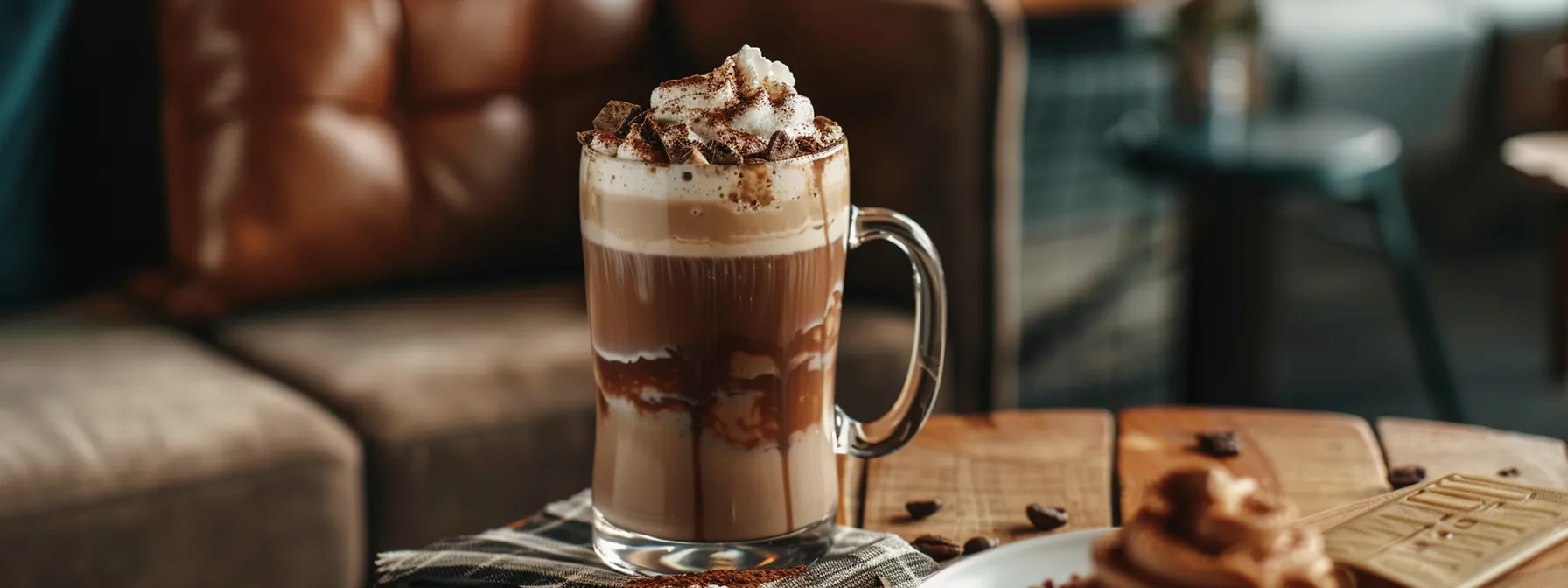
To make the perfect chocolate latte at home, you need to understand its unique qualities. Learn what sets it apart from other coffee drinks, discover the importance of quality ingredients like oat milk and chocolate syrup, and master milk frothing techniques. These elements combine in a glass to create a delicious drink that’s both comforting and indulgent.
What Makes a Chocolate Latte Different From Other Coffee Drinks
A chocolate latte stands out from other coffee drinks due to its unique blend of espresso, steamed milk, and rich chocolate syrup. Unlike a standard latte or cappuccino, it offers a sweet, indulgent flavor profile that appeals to both coffee and chocolate lovers. You can customize your chocolate latte by using different types of milk, such as oat milk, or by adding a touch of eggnog for a festive twist. For a refreshing summer version, try serving it over ice, or top it with a dollop of whipped cream and a sprinkle of cocoa powder for a dessert-like treat reminiscent of chocolate cake.
The Role of High-Quality Ingredients in Flavor
High-quality ingredients elevate your chocolate latte from ordinary to extraordinary. Choose premium espresso beans, rich chocolate syrup, and fresh milk for the best flavor. Consider experimenting with almond milk for a nutty twist or adding a touch of caramel for extra sweetness. For a festive touch, top your latte with marshmallows or create a cocktail-inspired version by incorporating flavored liqueurs. Remember, the heat of your milk affects the final taste, so maintain the right temperature for optimal flavor extraction.
The Importance of Milk Frothing Techniques
Mastering milk frothing techniques is crucial for creating the perfect chocolate latte. You’ll need to heat your milk to the right temperature, typically around 150°F, to achieve optimal flavor and texture. Use a moka pot or steam wand to froth the milk, incorporating air to create a creamy microfoam. For a richer taste, add a tablespoon of hot chocolate powder or protein to your milk before frothing. This technique not only enhances the flavor but also creates a silky-smooth texture that complements the espresso and chocolate syrup perfectly.
Gathering the Ingredients and Equipment
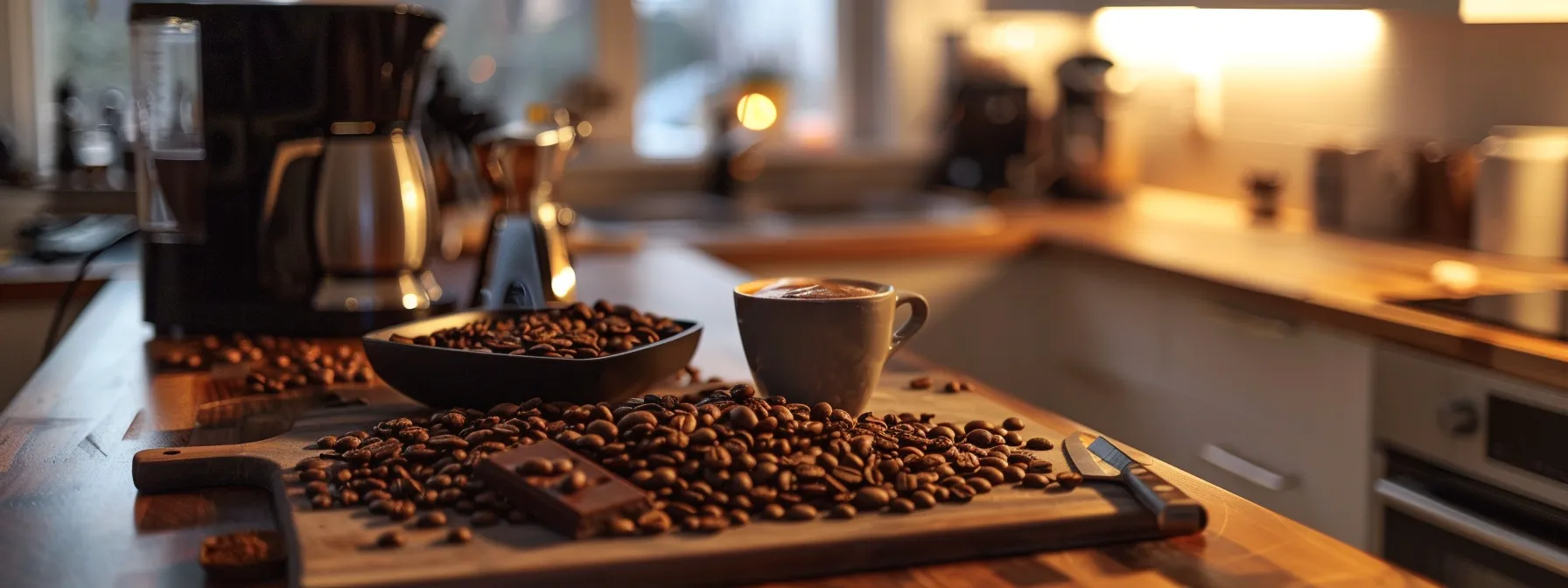
To create the perfect chocolate latte at home, gather essential ingredients and equipment. You’ll learn about selecting coffee beans, choosing chocolate, and acquiring necessary tools. We’ll also explore optional add-ins to enhance flavor, helping you craft a coffeehouse-quality drink. Whether you’re preparing a Christmas treat or a nutrient-rich alternative using non-fat milk, these tips will elevate your latte-making skills.
Selecting the Best Coffee Beans for Your Latte
When selecting coffee beans for your chocolate latte, choose a medium to dark roast espresso blend that complements the rich chocolate flavor. Look for beans with notes of caramel, nuts, or cocoa to enhance your latte‘s taste profile. Consider the caffeine content if you’re sensitive, and opt for a decaf option if needed. You can experiment with single-origin beans to discover unique flavor combinations that pair well with your chosen chocolate syrup or honey as a natural sweetener. Remember, freshly ground beans will provide the best flavor for your latte, elevating it from a simple menu item to a gourmet experience. Don’t forget to consider a garnish, such as cocoa powder or chocolate shavings, to add a finishing touch to your perfect chocolate latte.
Choosing the Right Type of Chocolate
Choose high-quality chocolate for your latte to achieve the best flavor. You can use chocolate syrup, cocoa powder, or melted chocolate, depending on your preference and recipe. For a richer taste, opt for dark chocolate with at least 70% cocoa content. If you enjoy a sweeter latte, milk chocolate or a combination of dark and milk chocolate works well. Consider experimenting with flavored chocolates, such as peanut butter-infused varieties, to create unique taste profiles. When making an iced coffee version, use chocolate syrup or melted chocolate to ensure smooth blending with cold water.
Essential Equipment for Homemade Lattes
To make the perfect chocolate latte at home, you’ll need essential equipment. Start with an espresso machine or a moka pot to brew strong coffee. Invest in a milk frother or steam wand to create creamy foam, which you can top with whipped cream for extra indulgence. Consider a blender if you plan to incorporate Nutella or coconut milk for unique flavor variations. Keep a sauce bottle handy for easy chocolate syrup application, and don’t forget a tall glass to showcase your creation. Remember, while lattes can be high in carbohydrates, you can adjust ingredients to suit your dietary needs.
Optional Add-Ins to Enhance Flavor
Enhance your chocolate latte‘s flavor with optional add-ins. Try a dash of vanilla extract or a sprinkle of spice like cinnamon or nutmeg for depth. Sweeten with brown sugar for a rich caramel note. Use oat milk for a creamy, nutty taste that complements chocolate well. If you don’t have an espresso machine, brew strong coffee on the stove using a moka pot for a similar effect.
Step-by-Step Guide to Making a Chocolate Latte at Home

Learn to craft the perfect chocolate latte at home with this step-by-step guide. You’ll discover how to prepare espresso, melt chocolate, froth milk, and combine ingredients for a delicious drink. We’ll cover tips on serving and presentation, including options like adding chocolate chips, cinnamon, or ice cubes for variety. Understand the nutritional aspects of your homemade latte as you master this coffeehouse favorite.
Preparing the Espresso Base
Begin by brewing a strong espresso base for your chocolate latte. If you don’t have an espresso machine, you can use a Nespresso pod or a French press to create a concentrated coffee. For a richer flavor, mix your espresso with chocolate syrup before adding milk. You can use soy milk as a dairy-free alternative, which pairs well with the chocolate notes. If you prefer a creamier texture, consider adding a touch of cream to your espresso base.
Melting and Incorporating the Chocolate
To melt and incorporate chocolate into your latte, start by heating chocolate milk in a mug or using a combination of milk and chocolate syrup from your pantry. For a dairy-free option, use almond milk and dark chocolate. Stir until the mixture is smooth, resembling a thin pudding consistency. This chocolate base will blend seamlessly with your espresso, creating a rich and indulgent chocolate latte.
Frothing the Milk to Perfection
To froth milk for your chocolate latte, use your espresso machine’s steam wand or a handheld frother. Heat the milk to 150°F while incorporating air to create a velvety foam. If you’re cooking up a special treat, consider pairing your latte with a chocolate cheesecake for an indulgent experience. Remember, the quality of your foam can make or break your latte, so take care to achieve that perfect microfoam texture reminiscent of lattes served in Italy.
Combining All Components
To create your perfect chocolate latte, combine the prepared espresso with the melted chocolate mixture in your mug. Gently pour the frothed milk over the espresso–chocolate base, allowing the foam to settle on top. For added flavor, consider stirring in a dash of vanilla extract or sprinkling instant coffee on the foam. If you prefer a cappuccino-style drink, use less milk and more foam. Serve your latte alongside a cookie for a delightful treat that rivals any café experience.
Serving and Presentation Tips
Present your chocolate latte in a clear glass to showcase its layers. Top with a dollop of coconut whipped cream for a dairy-free option that’s lower in saturated fat. Drizzle maple syrup over the foam for added sweetness without gluten. Garnish with a sprinkle of hazelnut for a nutty flavor that complements the chocolate. Serve alongside a gluten-free biscotti for a complete café experience at home.
Tips and Tricks for the Perfect Chocolate Latte
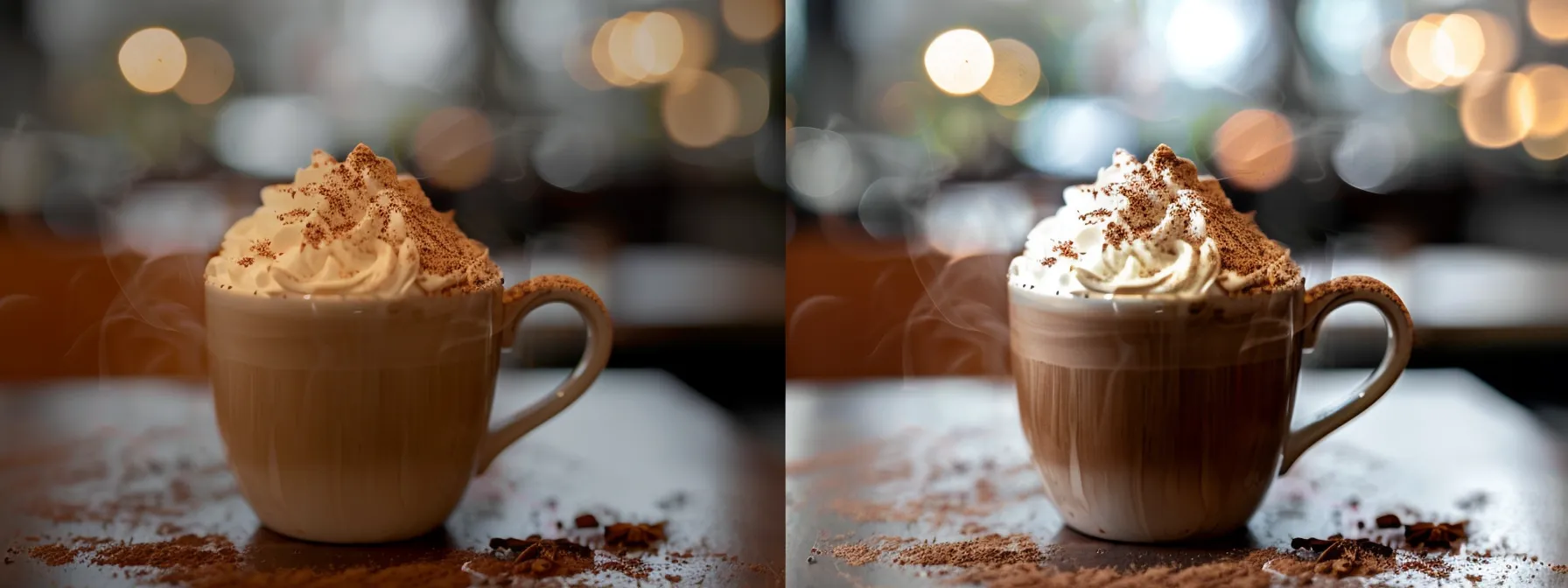
Refine your chocolate latte-making skills with these essential tips and tricks. Learn to adjust sweetness and strength, experiment with alternative milks, add depth with spices, and avoid common mistakes. From balancing sugar to creating smoothie-like textures, these techniques will elevate your kitchen creations. Discover how a simple teaspoon of the right ingredient can transform your chocolate latte experience.
Adjusting Sweetness and Strength to Your Taste
Adjust the sweetness and strength of your chocolate latte to suit your taste preferences. Use milk chocolate for a sweeter profile, or add a teaspoon of matcha for a unique flavor twist. For a richer taste, incorporate a small amount of butter into your drink. Experiment with pumpkin spice during fall for a seasonal touch. Remember, you can always add more chocolate or sweetener, but you can’t remove it, so start with less and adjust as needed.
Using Alternative Milks for Different Flavors
Experiment with alternative milks to create unique flavors in your chocolate latte. Oat milk offers a creamy texture and slightly sweet taste, while almond milk adds a nutty dimension. For a lower calorie option, try unsweetened coconut milk, which complements the chocolate flavor well. Use a mason jar to shake your chosen milk vigorously, creating a frothy texture similar to what a barista achieves. Remember, plant-based milks are typically lower in cholesterol, making them a heart-healthy choice for your homemade latte.
Adding Spices for Extra Depth
Enhance your chocolate latte‘s flavor profile by adding spices for extra depth. Sprinkle a pinch of cinnamon or nutmeg into your espresso before brewing to infuse the coffee with warmth. For a spicier kick, try adding a dash of cayenne pepper or a small amount of ginger to your chocolate syrup. These additions will create a more complex taste that elevates your homemade latte beyond the ordinary.
Common Mistakes to Avoid
Avoid common mistakes when making your chocolate latte at home. Don’t overheat your milk, as this can scald it and ruin the flavor. Use high-quality chocolate to ensure a rich taste, and avoid using too much syrup, which can overpower the coffee. Be careful not to over-extract your espresso, as this can lead to a bitter latte. Lastly, take care when frothing your milk to achieve the right consistency without creating large, unstable bubbles.
Customizing Your Chocolate Latte
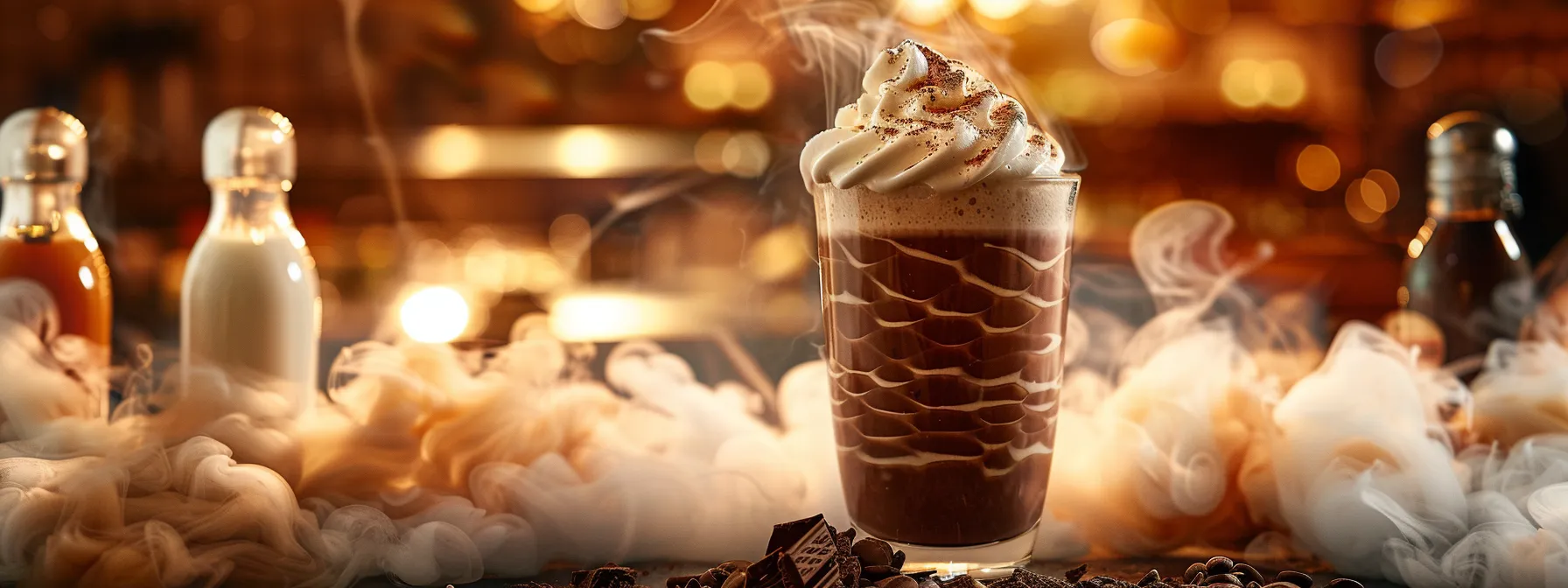
Customize your chocolate latte to suit your preferences and dietary needs. Learn how to create a mocha by adding whipped cream, explore seasonal variations for diverse flavors, and discover ways to make your latte vegan or dairy-free. These techniques will help you craft a personalized chocolate latte experience at home.
Turning It Into a Mocha: Adding Whipped Cream
Transform your chocolate latte into a mocha by adding a dollop of whipped cream on top. Prepare the whipped cream by whisking heavy cream until it forms soft peaks, then gently place it on your latte. For an extra touch of indulgence, dust the whipped cream with cocoa powder or drizzle it with chocolate syrup. This addition not only enhances the visual appeal but also adds a creamy texture that complements the rich chocolate and coffee flavors in your drink.
Seasonal Variations to Try at Home
Experiment with seasonal variations to add festive flair to your chocolate latte. In autumn, incorporate a pumpkin spice blend into your chocolate syrup for a cozy twist. During winter, try adding a dash of peppermint extract or crushed candy canes for a holiday-inspired drink. For spring, infuse your latte with lavender syrup, and in summer, create a refreshing iced version by blending your chocolate latte with ice and topping it with cold foam.
Making It Vegan or Dairy-Free
Create a vegan or dairy-free chocolate latte by substituting plant-based milk alternatives. Use almond, soy, or oat milk as your base, ensuring they’re barista-grade for optimal frothing. Replace chocolate syrup with a vegan version or mix cocoa powder with plant-based sweetener. For added richness, incorporate coconut cream or cashew butter. Remember to check that your coffee and any additional flavorings are also vegan-friendly to maintain the integrity of your dairy-free creation.
Frequently Asked Questions About Chocolate Lattes
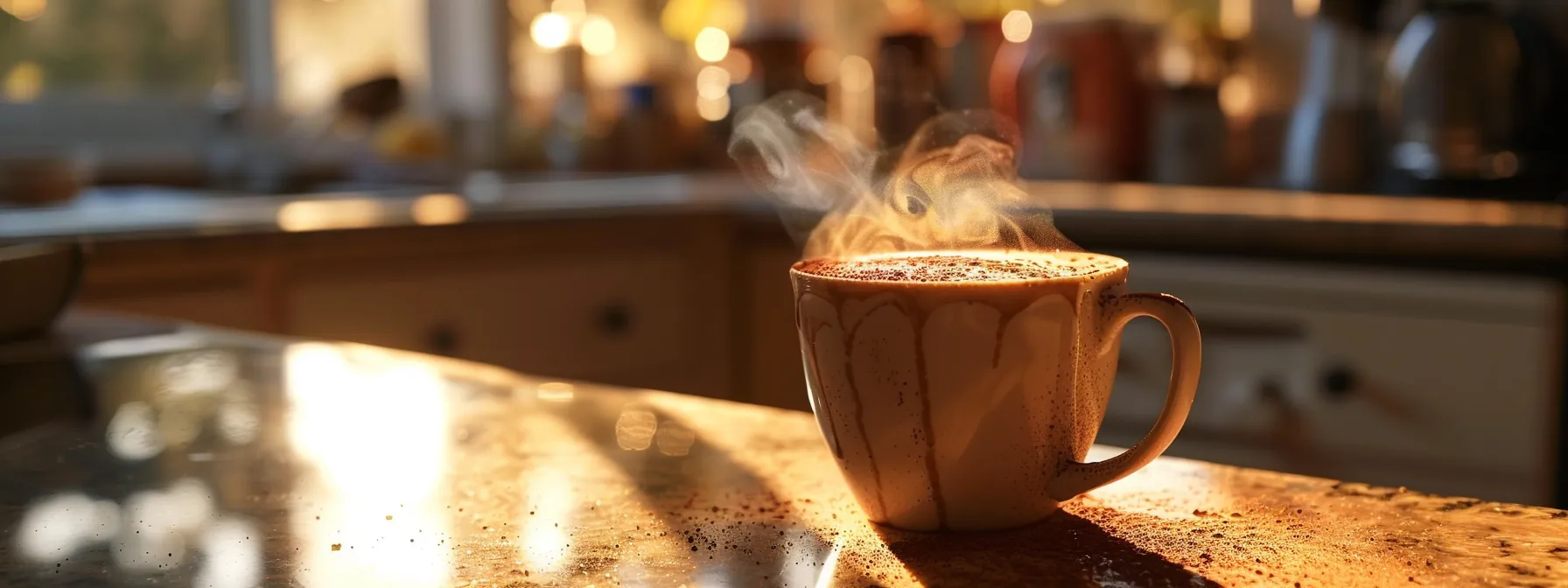
Discover answers to common questions about making chocolate lattes at home. Learn if you can use cocoa powder instead of chocolate, find out the best milk type for your latte, and explore how to create a decaf version. These insights will help you perfect your chocolate latte-making skills and customize your drink to your preferences.
Can I Use Cocoa Powder Instead of Chocolate?
Yes, you can use cocoa powder instead of chocolate in your latte. Mix 1-2 tablespoons of unsweetened cocoa powder with hot water or milk to create a chocolate syrup substitute. This option allows you to control the sweetness level by adding sugar or a sweetener of your choice. Cocoa powder also provides a more intense chocolate flavor compared to pre-made syrups, giving your latte a rich, authentic taste.
What Is the Best Type of Milk to Use?
Whole milk provides the richest texture and flavor for your chocolate latte, but you can choose based on your preferences and dietary needs. Skim milk offers a lighter option, while 2% strikes a balance between richness and reduced fat content. For non-dairy alternatives, oat milk froths well and complements chocolate flavors, while almond milk adds a nutty note. Consider the milk‘s fat content and how it affects the latte‘s creaminess and calorie count when making your selection.
How Do I Make a Decaf Version?
To make a decaf version of your chocolate latte, simply substitute decaffeinated espresso or strong decaf coffee for the regular espresso in your recipe. You can use decaf espresso pods, instant decaf coffee, or brew decaf coffee beans in your preferred method. The rest of the ingredients and preparation steps remain the same, allowing you to enjoy the rich chocolate flavor without the caffeine kick.
Conclusion
Mastering the art of making a perfect chocolate latte at home allows you to enjoy a luxurious coffeehouse experience without leaving your kitchen. By understanding the essential components, selecting quality ingredients, and honing your techniques, you can create a customized beverage that rivals professional baristas’ offerings. Experimenting with various add-ins, milk alternatives, and seasonal variations enables you to tailor your chocolate latte to your personal preferences and dietary needs. With practice and attention to detail, you’ll soon be crafting delicious chocolate lattes that satisfy your cravings and impress your guests.

